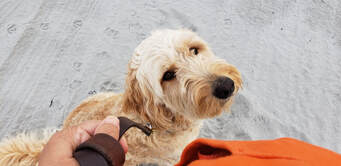
My definition of a dog training correction is to further advance a position, speed, or behavior through communication the dog understands to mean what they had just done is not what was wanted and therefore offers another option or stops something. Some examples of corrections are verbal markers, spatial pressure, and the use of some training equipment. Please note that corrections should not be used, generally speaking, until the dog has started and advanced through the first stages of dog training, which is teaching. Once a performance can be reliably predicted to a standard, then you are ready to correct errors or non performance.
Why would a dog owner want a way to correct their dog anyway?
- Unwanted jumping
- Constant barking
- Trying to escape through doors when opened
- Lunging at people, other animals, or cars while on leash
- Not returning when called
- Stealing and running away with items
- Bratty or bullying behaviors
Why would a dog not be focused on your or intentionally not do what was asked?
- The pull of a distraction is greater than your reward or approval at the time
- Fear or defensiveness of a trigger
- Burnt out from too much training (corrections would not be applied, dog gets to rest)
- Sick, too hot or too cold (again not a category that requires corrections)
- Living beings that are not perfect
- Confused or misunderstanding what is being asked
There are many genetic and instinctive drives that dogs have. These drives can be hard to override at times. Prey drive would be an example of a compulsion that is very compelling and rewarding to a dog. However, you don't want the environmental corrections (corrections that happen without a dog owner's express involvement) to correct your dog. Environmental corrections are cars, barbed wire, ice, suspicious food, or another animal. Those corrections do tend to be harsh and sometimes fatal.
Remember that training needs to be started from stage one before corrections are started. This is because dogs will not necessarily know what they are being corrected for and more importantly what we would like them to do instead. If you correct a dog cold for something you have just decided you don't like, there are too many variables for the dog to try to figure out. It will be unclear to them, and they can not read your mind. Whereas a command is a very clear direction when it is taught and trained well. Once you have a reliable performance standard trained, then you are ready to start corrections and the dog will understand what is wanted.
What are some types of corrections?
- Verbal, typically part of a marker system
- Spatial pressure, which means using your body and movements to influence the dog
- Collar corrections are when a leash or tab are used to make a quick loose tight loose motion with the collar
- Ignoring is when you do not respond to an incorrect response or unwanted behavior
- Withholding a reward until the right response is made
- Shake cans are sometimes used to distract or get a dog's attention when they are doing something unwanted (although I usually do not consider this training)
These things can be used in beginning training OR to correct sloppy or incomplete training (usually this is correcting the trainer's training):
- Wooden rectangle on ground with room enough for dog's body and open at the one of the narrow ends. This helps with things like fronts and other things.
- Tabling (this is where a dog is trained commands on a platform) could also help correct with a dog that lacks focus, as they need to stay on the table (different than place usually).
- Walls or any straight areas that the dog can be worked up against can be used to straighten out a heel.
- A heeling stick can also be used to straighten out a heel, by teaching the dog to move in when they feel the stick on their side or hip.
- The Gentle Leader
- The type of harnesses that go under the dog's front legs to hinder movement
- Citronella collars
There are probably many things I have not addressed here. I want this article to show that corrections are not harsh and cruel in dog training terms, although anyone can be abusive with anything. Corrections are simply a way to improve performance by giving more feedback and information to a dog that has already started and is into the training process for more reliability and function in the team communication.
 RSS Feed
RSS Feed